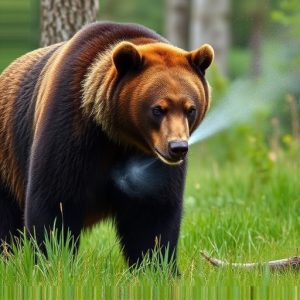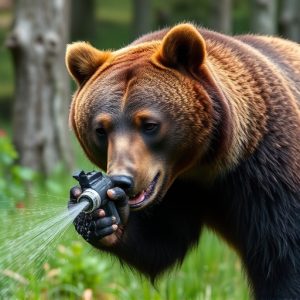Mastering Alaska Bear Spray: Patterns, Safety, and Best Practices
Understanding bear spray fog patterns (20-30 feet range) is key to preventing accidental discharges…….
Understanding bear spray fog patterns (20-30 feet range) is key to preventing accidental discharges in wild environments, especially Alaska's wilderness. Safeguard against unwanted activation by storing spray away from heat and direct sunlight, practicing trigger control, inspecting for damage, adhering to local regulations, aiming at close range with firm bursts, securing canisters, navigating terrain carefully, and carrying backup deterrents.
“In Alaska’s vast wilderness, encountering bears is a reality for outdoor enthusiasts. Understanding the guard Alaska bear spray fog pattern is crucial for your safety. This article delves into the intricacies of bear spray fog patterns, offering insights on preventing accidental discharges—a critical skill for navigating Alaska’s rugged terrain.
We explore strategies to ensure responsible use, focusing on best practices to maximize protection while minimizing risks associated with accidental bear spray discharge prevention.”
- Understanding Bear Spray Fog Patterns: What You Need to Know
- Strategies for Preventing Accidental Discharge While Using Bear Spray
- Best Practices for Safe Bear Spray Use in Alaska's Wilderness
Understanding Bear Spray Fog Patterns: What You Need to Know
Understanding Bear Spray Fog Patterns is crucial for anyone venturing into bear country. Knowing how bear spray fog behaves can help prevent accidental discharges and ensure maximum effectiveness when needed. Bear spray is designed to create a dense, floating fog that lingers in the air, allowing for a wider area of coverage than a direct spray. This fog pattern is achieved through specialized nozzles that break down the spray into tiny droplets, increasing its surface area and airborne time.
To avoid accidental discharges, it’s essential to understand how close you can get to bears while still being protected by the fog pattern. The ideal range for bear spray is generally considered to be between 20-30 feet (6-9 meters), though this can vary based on factors like wind and the specific product used. By staying within this range and aiming slightly above the bear’s head, you can ensure the fog pattern covers the bear effectively without accidentally activating it through close contact or aggressive movements.
Strategies for Preventing Accidental Discharge While Using Bear Spray
When carrying and using bear spray, preventing accidental discharge is paramount for your safety in the wild. A moment’s carelessness can have severe consequences, so it’s crucial to implement preventive measures. One effective strategy is to always store the spray in a secure, closed container, keeping it away from heat sources or direct sunlight, which can cause it to activate unexpectedly. Additionally, ensure you and your companions are well-trained in its use; practice trigger control and understand the proper technique to minimize the risk of accidental discharge.
During outdoor activities, keep bear spray readily accessible but out of reach, especially when cooking or sitting down for meals. The fog pattern can be triggered by a simple twist or jolt, so remain calm and deliberate in your actions. Regularly inspect the spray for any signs of damage or wear before each trip, and check local regulations regarding storage and use to adhere to specific guidelines, ensuring a safe outdoor experience.
Best Practices for Safe Bear Spray Use in Alaska's Wilderness
When using bear spray in Alaska’s wilderness, prioritizing safety is paramount to prevent accidental discharges that could harm both you and wildlife. Always ensure proper handling by keeping the canister upright and secure, avoiding extreme temperatures, and storing it out of reach of children and pets. Before deploying, verify that your spray is still functional and check the expiration date. During use, aim for the bear’s face at close range (around 20-30 feet) and spray in short bursts to ensure maximum effectiveness while minimizing wind dispersion.
To prevent accidental discharges, keep a firm grip on the canister during application, especially when navigating rugged terrain or in high winds. Store bear spray canisters in designated compartments or secure bags while outdoors to reduce the risk of accidental activation. Additionally, familiarize yourself with local regulations regarding bear spray use and carry a backup form of deterrence, such as noise makers or a physical deterrent like pepper spray, for added safety measures.
When venturing into Alaska’s wilderness, understanding and practicing safe bear spray usage is paramount. By familiarizing yourself with fog patterns and implementing strategies to prevent accidental discharges, you significantly reduce risks during encounters with bears. Always follow best practices, stay calm, and remember that prevention is key when navigating the unique challenges of Alaska’s environment. With proper preparation and awareness, you can enjoy a safer outdoor experience while exploring this breathtaking landscape.


